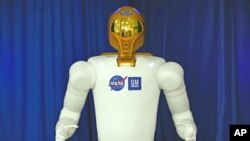The U.S. space agency had planned for the first human-like robot on the International Space Station to make its operational debut on the orbiting lab Thursday, six months after the space shuttle Discovery delivered it to the station. NASA said Robonaut 2 did not get to make its first moves because of "commanding issues," but the robot's sensors are working properly.
The first human-like robotic resident on the space station cuts a pretty imposing figure. Robonaut 2 has the upper torso and arms of a muscular superhero, dressed in a body-hugging white suit and gloves. Its head resembles a golden, gleaming, face-obscuring motorcycle helmet. Its five-fingered hands are designed with joints to grip tools, just as human hands can.
While Robonaut 2, or R2 as it is sometimes called, isn't human-like-enough to have legs, it does have a Twitter account with the handle AstroRobonaut.
Thursday morning's Tweet - written, of course, by humans involved in the Robonaut project - read "Power up! Delicious energy..." with slang words to mimic sound effects, underscoring that the energy was, indeed, delicious.
Robonaut was created by NASA and the American car manufacturer General Motors. Nic Radford is the Robonaut deputy project manager.
"The people on the ground, we just get giddy when we see, you know, the prompt - the little blinking prompt that shows us that Robonaut has come to life again," said Radford.
While R2 came to life, so to speak, on the space station Thursday morning, NASA said "commanding issues" prevented R2 from moving its joints as planned. NASA engineers on the ground had hoped to send commands to R2 to move its arms and hands. Still, Radford said, R2 booted up properly, and engineers hope to try some movements again in two weeks, depending on the schedules of the human crew members on the space station.
Radford said they hope to tune the robot to operate in the space station's zero-gravity environment in mid-September. The plan is for R2 to be controlled by NASA engineers on the ground and by astronauts in space.
Once it's fully operational, the robot could do some of the monotonous dirty work on the station, such as cleaning railings and changing air filters. Radford noted that six-year-olds and astronauts have something in common - a desire to have someone or something do their chores for them.
Ultimately, NASA said, the robotic crew member could be upgraded to do some more advanced work, including spacewalks.
Space Station's Robotic Astronaut Gets Powered Up











